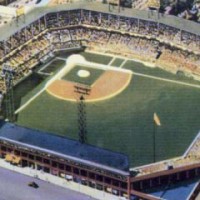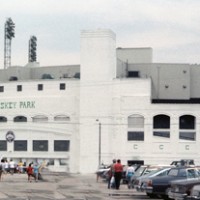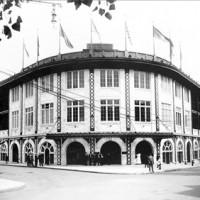Frizzi: There used to be a ballpark right here
"And the sky has gotten cloudy
when it used to be so clear
and the summer....went so quickly...
this year....
"Yes, there used to be a ball park...
right here...."
Written by: Joe Raposo
Lyrics © Warner/Chappell Music, Inc.
One of the things I believe sets baseball apart from the other sports is baseball's appreciation for its history. No sport celebrates its past better than baseball. Babe Ruth and Lou Gehrig, who played for the Yankee powerhouse team in the 1920s, are still revered. The sight of Cubs Hall of Famer Ernie Banks, 82 years young, still turns middle-aged men into star-struck school kids, myself included.
I still listen to Dodger games on satellite radio and marvel that broadcaster Vin Scully, who has already signed up for his 65th season in baseball broadcasting, sounds as exuberant as he probably did when he started to call games for the old Brooklyn Dodgers. It reminds me of the days of listening to Bob Prince, Jack Buck, Ernie Harwell, Harry Caray and Vince Lloyd through a small transistor radio speaker.
It helps that I'm a history nerd (to me, a geek is one who is gainfully employed with a roadside carnival and bites the head off of chickens). However, instead of studying the seamy underbelly of politics and the horrors of war, I prefer to study the glorious history of baseball.
I've been to Gettysburg and found the place still be engulfed with the pall of sadness. But to visit the site of a baseball park, to stand on the grounds where the great ones once played, still brings a shiver up and down my spine. It also helps me relive my youth. I can go to the sites of Forbes Field and Three Rivers Stadium (both in Pittsburgh) and go back to being a kid again.
Of course, only two of the grand old parks still exist. There's Fenway Park in Boston and of course, Chicago's Wrigley Field. For me, it's interesting to visit the former sites of the grand old green cathedrals. Some of them are creatively marked.
When I was at Busch Stadium during the Pirates-Cards playoffs, I pointed out to visiting Pirates fans that the white line crossing through the walkway in left field was the right field foul line of Busch Memorial Stadium and that right field of the old Busch, where Roberto Clemente played when the Pirates were in town, intersected the current Busch Stadium's left field. The first base line outside the park, going up to the Jack Buck bust, is the approximate site of first base, where Albet Pujols and Willie Stargell used to stand guard.
It's great that St. Louis is finally doing something with the vacant lot that was Busch II. It used to be a giant hole filled with water that I had nicknamed "Lake Gibson." They are building a new section of the park with left field stands just across Clark Street, similar to what Wrigley has. It probably will have a watering hole of some sort. I hope it will house the return of the St.Louis Baseball Hall of Fame, which used to be down the left field line at Busch II and was later moved across the street.
(Editor's note: It is called Ballpark Village and indeed will have a couple watering holes as well as other retail and residential. The Cardinals Hall of Fame Museum will relocate there.)
However, if you want to see where Stan Musial, Marty Marion and the Gas House Gang played, just take a 10-minute drive northwest to the corner of Grand and Dodier, where Sportsman Park used to stand. The former home of the Cards and the St.Louis Browns is now the site of the Herbert Hoover Boys and Girls Club. Parking your car on Dodier, you can see signs on the club's building telling you the history of Sportsman Park. Walking to the corner of Dodier and Spring has you walking past the home offices of the Cards and Browns. In 1944, both teams met each other in the only World Series to be played completely in St. Louis.
The new ballpark across the street with the Sportsman Park scoreboard actually sat on a parking lot for the original Sportsman's. If you go onto the football field and stand on the corner of the end zone, you are standing approximately on home plate. Look down the left field line and you can envision the giant manually operated scoreboard. Look straight ahead and you can see what used to be the YMCA (prevalent in many pictures of the park) still located in dead center field and across the street on Grand and Sullivan.
August Busch, the owner of the Cardinals, donated the site of Sportsman's Park to the Boys and Girls Club of St. Louis. If you're lucky, you'll see kids and coaches practicing on the field.
The Browns played at and owned Sportsman Park until 1953 when Bill Veeck sold it to August Busch. Busch attempted to rename the park "Budweiser Stadium" but the National League felt that naming a ballpark after a product would reek of crass commercialism. Busch's argument was that Wrigley Field advertised Wrigley's gum. So, Busch contacted the old brewmaster at Griesedieck Bros brewery and created Busch beer and Busch Stadium.
The neon Budweiser eagle that sat on the scoreboard of Busch Stadium is rumored to still exist, in all its splendor, on a Budweiser sign as you head west on Highway 40 in Downtown St.Louis.
Most Cardinal fans are not aware that the Cardinals initially played in a wooden stadium known as Robison Field up until 1920. The site of the park is located at the corner of Natural Bridge Avenue and Vandeventer Avenue and is now the site of Beaumont High School and their athletic field. When I was there a group of kids came onto the field with a soccer ball. I don't think they knew they were playing on a field of legends.
Over time, I've visited other ballpark sites. Here are a few of them:
COMISKEY PARK, CHICAGO: The site of the first All-Star Game and the 1919 Black Sox World Series has been marked with home plate and the foul lines. The ramp that sits across West 35th Street from "The Cell" (Cellular Field, the White Sox current stadium) is built in the same angle as the part of Comiskey Park that housed the White Sox's front office. The site is now a parking lot but it would've been great if they would've left the bleachers intact, turning that into a White Sox Hall of Fame. Or McCuddy's Tavern.
TIGER STADIUM, DETROIT: The corner of Michigan and Trumbull was the site of baseball stars from Ty Cobb to Hank Greenburg to Al Kaline. The site is now named "Ernie Harwell Park" after the iconic Tiger broadcaster and is a ball field complete with the dirt infield Alex Trammell and Lou Whittaker once patrolled.
EBBETS FIELD, BROOKLYN: The original home of the Dodgers is also where Jackie Robinson broke the color barrier in 1947. It's now the site of the Ebbets Field Apartments, a public housing facility. Home plate is rumored to be inside someone's living room. Across from McKeever Place, which ran parallel to Ebbets' left field line, is The Jackie Robinson Public School #375. Walk south on Bedford Avenue and into the parking lot and you are in standing right field. A courtyard runs down what would've been right field to first base.
FORBES FIELD, PITTSBURGH: Every October 13, Pirates fans gather at what is left of the brick outfield wall, still complete with ivy, the outfield numbers and flagpole, and listen to the audio of Game 7 of the 1960 World Series. That's the one where Bill Mazeroski hit the tie-breaking homer in the bottom of the ninth inning to beat the Yankees in the series. Forbes sat on the site of the University of Pittsburgh's law and business schools. Roberto Clemente Drive winds through the site.
HUNTINGTON AVENUE GROUNDS, BOSTON: About two miles and some change southeast of venerable Fenway Park is Northeastern University, located on the site of the Red Sox's first home, the Huntington Avenue Grounds. It was the home of Boston's American League franchise (also known as the "Americans" or the "Pilgrims") and the site of the first World Series, played in 1903. Barney Dreyfuss, owner of the National League Champion Pittsburgh Pirates challenged Boston owner Henry J. Killilea to a best-of-nine series, which Boston would win in eight games.
A plaque on the Huntington Theatre Company's building on Huntington Avenue marks the spot of the first World Series. But if you go to St. Botolph Street, between the Theatre and the Matthews Arena, you'll find a statue of series hero Cy Young pitching toward a brass home plate that also marks the site.
(Boston does a far better job than Pittsburgh in marking the site of the first World Series. While the state of Pennsylvania did mark the site with a plaque, the only other mark is by someone with gold spray paint, marking home plate and the bases. The site, a parking lot on the corner of General Robinson Street and Tony Dorsett Drive, just west of PNC Park, is also the approximate site of Three Rivers Stadium. The Gate "D" marker of Three Rivers remains and is now a part of the Steelers' Heinz Field.)
Just a mile west of Fenway Park on Commonwealth Street is Boston University's Nickerson Field. It sits on what was once Braves Field, home of the Braves before they moved to Milwaukee in 1953. The field is now a soccer pitch. The building that housed the front office and ticket office still exists as do the right field bleachers (still in use) and the right field wall. The concourse beneath the bleachers has changed very little since it was a part of Braves Field. The Red Sox played the 1915 World Series against the Philadelphia Phillies at Braves Field instead of Fenway Park because, at that time, Braves Field had a larger capacity.
I'd be remiss if I didn't mention both of Peoria's lost ballparks. Now known as Shea Stadium, Bradley University's soccer pitch was the incubator of Albert Pujols, Yadier Molina, Mark Grace, Greg Maddux and Joe Girardi. That was when it was known as Meinen Field and its second reincarnation as Pete Vonachen Stadium. The bleacher seats, ticket booth and the announcer's booth are the only parts remaining of the baseball park, very similar to Braves Field in Boston.
Potential future baseball stars still play at Woodruff Field, which was built in 1920 on Northeast Adams Street, across the street from the Peoria's old Lake View Park. Woodruff was home to the Peoria Tractors of the Three-I League and other leagues until 1937. Hall of Fame Yankee second baseman Tony Lazzeri played for the Tractors in 1923, when he batted .248 with 14 home runs in 135 games. The Peoria Chiefs would rejoin the Three-I league in 1953 until 1957. During that time, the Chiefs were a farm team of the Cleveland Indians. The field and diamond still sits just west of the Komatsu Dresser factories. A portion of the old park's wall still exists on Grant Street.
The new ballparks are indeed beautiful. But Clemente didn't play there, nor did Stargell, Mays, Aaron or Musial. And when you're sitting in Wrigley after seeing a game at the new Comiskey — no, U.S.Cellular Field — can you honestly tell me you don't wish Old Comiskey still existed?
All I know is when they tore down the first Yankee Stadium, I realized that nothing was sacred.



